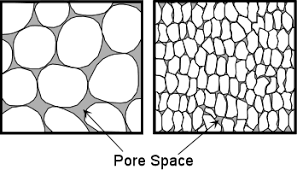Soil Porosity
- Soil porosity is the fraction of the total soil volume that is occupied by the pore space. The pore space of a soil refers to the portion of the soil volume taken up by air and water.
- Pore-spaces directly control the amount of water and air in the soil and indirectly influence the plant growth and crop production. Further, size of individual pores, rather than total pore space in a soil, is more significant in its plant growth relationship.
- Porosity or pore space is inversely related to bulk density. Porosity is calculated as a percentage of the soil volume:
Type of Pore Space
In broad sense there are two types of pores in soil.
- Macro pores: Pores larger than 0.06 mm in diameter are called Macro pores. Macro-pores allow air and water movement readily. Sands and sandy soils have a large number of macro-pores.
- Micro or Capillary pores: The diameter of these pores is less than 0.06 mm. The movement of air and water is restricted to some extent in micro or capillary pores. Clay and clayey soils have a greater number of micro or capillary pores. It has got more importance in the plant growth relationship.

How is Soil Porosity Calculated?
Soil Porosity = (1 – (Bulk Density ÷ Particle Density) ) x 100. This formula gives result in soil that contains pores.
Example: if a sandy soil, with organic matter content of 20%, has a bulk density of 1.4 g cm-3, and an average particle density of 2.222 g cm-3 then the soil porosity is as follows:
(1 – (1.4 ÷ 2.222)) x 100 = (1 – (0.63) ) x 100 = 37%.
The remaining 63% is the solid material of the soil itself.
Factors Affecting Porosity of Soil
- Soil structure: Particle arrangement determines the total pore space in the soil. A soil having granular and crumb structure contains more pore spaces than that of prismatic and platy soil The well aggregated soil structure has greater pore space as compared to structure-less or single grain soil.
- Soil texture: Sandy soils have lesser total pore space whereas, fine textured clay and clay loam soils have higher total pore space.
- Organic matter: Addition of organic matter increases the volume of pore space by lowering the bulk density. It makes the soil more porous.
- Compaction: If the soil is made more compact by movement of machinery and tillage implements, pore space is reduced. Intensive crop cultivation tends to lower the porosity of soil as compared to fallow soils.
See also…
Physical & Chemical Properties of Soil
SOIL ORGANIC MATTER- MEANING & COMPONENT
SOIL CONSISTENCY- MEASURE AND ATTERBERG LIMIT
SOIL WATER- CLASSES AND AVAILABILITY